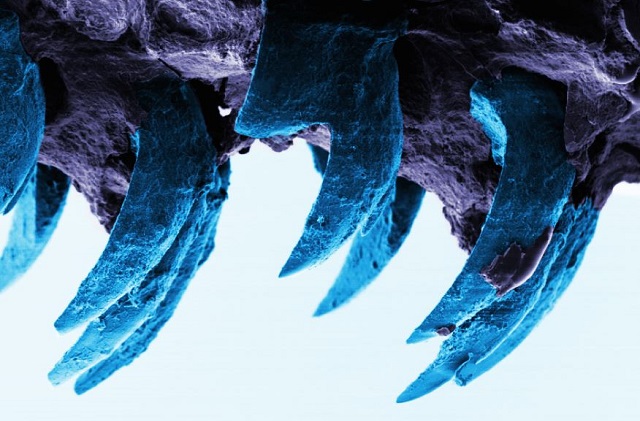
An image of Limpet teeth taken with a Scanning Electron Microscope (SEM)
Image credit: University of Portsmouth
A new study has concluded that limpet teeth could be the strongest natural material that man has ever known. University of Portsmouth researchers have found that tiny aquatic, snail-like creatures with conical shells, called limpets, possess these phenomenally strong teeth.
The biological structure of the limpet teeth, if imitated, could help create some of the strongest planes, cars and boats ever made in the future. With the help of atomic force microscopy (AFM), the researchers studied the mechanical behavior of teeth from limpets at the atomic scale.
The research was led by Professor Asa Barber from the University’s School of Engineering. He discovered that the teeth contained a hard mineral called goethite, which is formed in the limpet during growth.
Nature is a wonderful source of inspiration for structures that have excellent mechanical properties. All the things we observe around us, such as trees, the shells of sea creatures and the limpet teeth studied in this work, have evolved to be effective at what they do.
Until now we thought that spider silk was the strongest biological material because of its super-strength and potential applications in everything from bullet-proof vests to computer electronics but now we have discovered that limpet teeth exhibit a strength that is potentially higher.
Professor Asa Barber
University of Portsmouth's School of Engineering
The strength of the teeth was also proven to be constant no matter the size of them. The material tested by Professor Barber was 100 times finer than the diameter of a human hair. The methods used to test this kind of a sample have only recently been discovered.
Professor Barber stated that “limpets need high strength teeth to rasp over rock surfaces and remove algae for feeding when the tide is in." He went on to say that the research team found that the goethite fibres were the perfect size to produce a high strength composite structure.
The researchers believe that the limpet teeth's fibrous structures could be imitated and then potentially used in high-performance engineering such as Formula 1 racing cars, the hulls of boats and aircraft structures. Professor Barber said "Engineers are always interested in making these structures stronger to improve their performance or lighter so they use less material.”
Limpets feeding
Limpets Feeding - Video sourced from YouTube
The above video shows a limpet feeding in its own territory. These territories are often very small, only a few centimeters in size and they will feed from that location before returning to a resting location for their entire life. There are some limpets which do travel further to source food however.
Large structures tend to have many structural flaws and fracture more easily than a smaller ones. Barber stated that the issue is that most structures have to be large in size making them ultimately weaker. However, limpet teeth do not follow this rule as their strength remains unchanged no matter their size.
This research is a fantastic example of "bioinspiration", the technique of discovering perfect designs which pre-exist in nature and developing structures which mimic these designs.
This research has been published in the Royal Society journal Interface.
The testing methods were important as we needed to break the limpet tooth. The whole tooth is slightly less than a millimetre long but is curved, so the strength is dependent on both the shape of the tooth and the material. We wanted to understand the material strength only so we had to cut out a smaller volume of material out of the curved tooth structure.
Biology is a great source of inspiration when designing new structures but with so many biological structures to consider, it can take time to discover which may be useful.
Professor Asa Barber
University of Portsmouth's School of Engineering
This News Feature Around the Web